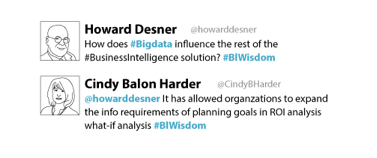In 1951, the concept of business intelligence was first introduced by J. Lyons Co. tea shops in the United Kingdom. At the time, these rudimentary 6,000 tube computers were used to determine how many cakes and sandwiches were to be made based upon information received from previous sales. Recent changes in these systems have brought about a nuance way of approaching the technical side of business.
[1] The trend of business analytics (BA) is simply an umbrella term for a much larger concept. Business analytics refers to enterprise information management, enterprise performance management, data warehousing, analytic applications, business intelligence, risk, compliance, and governance.
[1] Business intelligence (BI) is also an umbrella term, though it’s a much more focused concept. When a business utilizes tools, infrastructure, applications, and best practices that enable them to access and analyze data—which lead to improvements in optimization and performance—they’re using business intelligence.
[2] 
These keyword searches reflect the gradually falling trend of business intelligence while business analytics has grown rapidly since 2007.
Business Intelligence

Business Analytics 
The IT infrastructure for larger businesses relies on business analytics for their expanding needs. Business intelligence remains in use with these companies due to its integration with BA and its long-standing usability throughout the years.
[1] Here are a few ways modern companies and healthcare systems are capitalizing on this enterprise.
StoneGate Senior Living[3, 8]
The business intelligence company, Pentaho, aimed to increase StoneGate’s ROI by 2800% annually by integrating their strategies into the daily happenings of 29 senior care facilities. StoneGate’s biggest issue Pentaho uncovered was overtime pay. StoneGate was spending a good chunk of change on overtime and not monitoring the exact amount they were spending per cycle.
#BIWisdom Chat Regarding ROI

Not only were they overtaxing their employees, but also burning through an extra $2,088,677 on average year over year. By utilizing business intelligence, Pentaho proposed that with proper overtime tracking and scheduling software, it would lead to an increase in customer satisfaction and cost structure. While StoneGate may have been able to see this information before, it would have required monotonous and time-consuming manual calculations. By just reducing these overtime costs, StoneGate was able to save an estimated $5,000 at each facility every month. Though Pentaho didn’t hit the goal they were aiming for initially, they managed to save the company around $1,740,000 a year. This is but one case of many where business intelligence was used to turn a company’s losses into profits. Some of you may be familiar with Pentaho, but many may not be familiar with the features in involves. In an interview this April with Pentaho co-founder and CTO James Dixon, he describes exactly what his company does for BI users. Essentially, their OLAP engine, Mondrian, chops multi-dimensional data into bite-sized, interpretable data. Then Pentaho Reporting delivers web-based or desktop data delivery in the form of a PDF, excel spreadsheet, CSV document, HTML, or a variety of other formats.
[12] Kettle, Pentaho’s data transformation engine, helps to distribute data in order to bridge the gap between IT and business. Weka is another piece of software that analyzes various forms of data. Overall, Pentaho’s business intelligence interface ties data together into a readable and real-time dashboard.
[12]
Healthcare [4]
Among other reasons, business intelligence has become pertinent within the medical community for a variety of reasons, including the need to: ○ Improve patient satisfaction ○ Better treatment outcomes ○ Stifle rising costs ○ Follow regulations ○ Reel in and retain their medical staff
Cutting costs Most BI-centric health organizations are saving money by eliminating waste and mining data stores to evaluate and resurrect denied claims.
Satisfying patients Using a combination of analytics tools and business intelligence, many top-of-the-line health care organizations have seen a 15 percent increase in patient satisfaction.
Providing overall better care It’s believed that BI and BA services are key components to enabling improved performance management. This is an integral solution, which moves toward the improvement of patient satisfaction and subsequent medical results. Additionally, business intelligence helps healthcare providers maintain regulatory standards while snipping costs across the board. Among others, the Denver Health and Hospital Authority exercise the use of BI tools to analyze point-of-care data for the identification of risky or inconsolable patients. Ultimately, this improves the quality of care that patients receive during their hospital stay.
Industries and Adoption [5]
Consulting and technology sectors are currently the leaders in business intelligence adoption. Though the retail and wholesale industry once made up over 25 percent of overall BI integration, they currently only make up a fraction of the total adoption rate. Historically, smaller businesses—those with 101 to 1,000 employees—have a consistently high rate of adoption. Large organizations—comprised of more than 10,000 employees—have been inconsistent in recent years with their level of BI usage, though they once made up nearly one out of every three implementations.
#BIWisdom Chat On Structured and Unstructured Content

Mid-sized businesses appear to have fallen short, and their rate of integration is somewhat lackluster compared to the smaller and larger companies. This is an interesting statistic considering 89 percent of organizations that implemented a BI initiative have considered it a success. What technology did they prioritize to get there? Among other projects, they focused on: ○ Setting up virtual dashboards ○ Plugging in a “self service” function for end users ○ Constructing data warehousing to store larger quantities of information ○ Improving upon their visualizations
Conclusion
Many companies have increased their profitability by utilizing business intelligence and business analytics. A variety of industries continue to integrate these systems to improve their everyday processes, though some remain skeptical of making the change. Perhaps as advanced computerized technology takes a more prominent role in corporate environments, more companies will be open to the prospect of BA initiatives.
 Sources
Sources [1]
http://timoelliott.com/blog/2011/03/business-analytics-vs-business-intelligence.html [2]
http://www.gartner.com/it-glossary/business-intelligence-bi/ [3]
http://www.pentaho.com/resources/89/roi-case-study-pentaho-stonegate-senior-living/ [4]
http://bit.ly/OkAOfR [5]
http://www.yellowfinbi.com/Document.i4?DocumentId=159663 [6]
http://www.google.com/trends/?q=business+intelligence [7]
http://www.google.com/trends/?q=business+analytics&ctab=0&geo=all&date=all&sort=0 [8]
http://slashdot.org/topic/bi/pentaho-founders-talk-bi/ [9]
https://twitter.com/warren_hart/status/198466992087375873 [10]
https://twitter.com/howarddresner/status/198467363300052992 [11]
https://twitter.com/cindybharder/status/198463565907238912 [12]
http://slashdot.org/topic/bi/pentaho-founders-talk-bi/  These keyword searches reflect the gradually falling trend of business intelligence while business analytics has grown rapidly since 2007. Business Intelligence
Business Analytics
These keyword searches reflect the gradually falling trend of business intelligence while business analytics has grown rapidly since 2007. Business Intelligence
Business Analytics  The IT infrastructure for larger businesses relies on business analytics for their expanding needs. Business intelligence remains in use with these companies due to its integration with BA and its long-standing usability throughout the years. [1] Here are a few ways modern companies and healthcare systems are capitalizing on this enterprise.
The IT infrastructure for larger businesses relies on business analytics for their expanding needs. Business intelligence remains in use with these companies due to its integration with BA and its long-standing usability throughout the years. [1] Here are a few ways modern companies and healthcare systems are capitalizing on this enterprise.
 Not only were they overtaxing their employees, but also burning through an extra $2,088,677 on average year over year. By utilizing business intelligence, Pentaho proposed that with proper overtime tracking and scheduling software, it would lead to an increase in customer satisfaction and cost structure. While StoneGate may have been able to see this information before, it would have required monotonous and time-consuming manual calculations. By just reducing these overtime costs, StoneGate was able to save an estimated $5,000 at each facility every month. Though Pentaho didn’t hit the goal they were aiming for initially, they managed to save the company around $1,740,000 a year. This is but one case of many where business intelligence was used to turn a company’s losses into profits. Some of you may be familiar with Pentaho, but many may not be familiar with the features in involves. In an interview this April with Pentaho co-founder and CTO James Dixon, he describes exactly what his company does for BI users. Essentially, their OLAP engine, Mondrian, chops multi-dimensional data into bite-sized, interpretable data. Then Pentaho Reporting delivers web-based or desktop data delivery in the form of a PDF, excel spreadsheet, CSV document, HTML, or a variety of other formats. [12] Kettle, Pentaho’s data transformation engine, helps to distribute data in order to bridge the gap between IT and business. Weka is another piece of software that analyzes various forms of data. Overall, Pentaho’s business intelligence interface ties data together into a readable and real-time dashboard. [12]
Not only were they overtaxing their employees, but also burning through an extra $2,088,677 on average year over year. By utilizing business intelligence, Pentaho proposed that with proper overtime tracking and scheduling software, it would lead to an increase in customer satisfaction and cost structure. While StoneGate may have been able to see this information before, it would have required monotonous and time-consuming manual calculations. By just reducing these overtime costs, StoneGate was able to save an estimated $5,000 at each facility every month. Though Pentaho didn’t hit the goal they were aiming for initially, they managed to save the company around $1,740,000 a year. This is but one case of many where business intelligence was used to turn a company’s losses into profits. Some of you may be familiar with Pentaho, but many may not be familiar with the features in involves. In an interview this April with Pentaho co-founder and CTO James Dixon, he describes exactly what his company does for BI users. Essentially, their OLAP engine, Mondrian, chops multi-dimensional data into bite-sized, interpretable data. Then Pentaho Reporting delivers web-based or desktop data delivery in the form of a PDF, excel spreadsheet, CSV document, HTML, or a variety of other formats. [12] Kettle, Pentaho’s data transformation engine, helps to distribute data in order to bridge the gap between IT and business. Weka is another piece of software that analyzes various forms of data. Overall, Pentaho’s business intelligence interface ties data together into a readable and real-time dashboard. [12]
 Mid-sized businesses appear to have fallen short, and their rate of integration is somewhat lackluster compared to the smaller and larger companies. This is an interesting statistic considering 89 percent of organizations that implemented a BI initiative have considered it a success. What technology did they prioritize to get there? Among other projects, they focused on: ○ Setting up virtual dashboards ○ Plugging in a “self service” function for end users ○ Constructing data warehousing to store larger quantities of information ○ Improving upon their visualizations
Mid-sized businesses appear to have fallen short, and their rate of integration is somewhat lackluster compared to the smaller and larger companies. This is an interesting statistic considering 89 percent of organizations that implemented a BI initiative have considered it a success. What technology did they prioritize to get there? Among other projects, they focused on: ○ Setting up virtual dashboards ○ Plugging in a “self service” function for end users ○ Constructing data warehousing to store larger quantities of information ○ Improving upon their visualizations
 Sources [1] http://timoelliott.com/blog/2011/03/business-analytics-vs-business-intelligence.html [2] http://www.gartner.com/it-glossary/business-intelligence-bi/ [3] http://www.pentaho.com/resources/89/roi-case-study-pentaho-stonegate-senior-living/ [4] http://bit.ly/OkAOfR [5] http://www.yellowfinbi.com/Document.i4?DocumentId=159663 [6] http://www.google.com/trends/?q=business+intelligence [7] http://www.google.com/trends/?q=business+analytics&ctab=0&geo=all&date=all&sort=0 [8] http://slashdot.org/topic/bi/pentaho-founders-talk-bi/ [9] https://twitter.com/warren_hart/status/198466992087375873 [10] https://twitter.com/howarddresner/status/198467363300052992 [11] https://twitter.com/cindybharder/status/198463565907238912 [12]http://slashdot.org/topic/bi/pentaho-founders-talk-bi/
Sources [1] http://timoelliott.com/blog/2011/03/business-analytics-vs-business-intelligence.html [2] http://www.gartner.com/it-glossary/business-intelligence-bi/ [3] http://www.pentaho.com/resources/89/roi-case-study-pentaho-stonegate-senior-living/ [4] http://bit.ly/OkAOfR [5] http://www.yellowfinbi.com/Document.i4?DocumentId=159663 [6] http://www.google.com/trends/?q=business+intelligence [7] http://www.google.com/trends/?q=business+analytics&ctab=0&geo=all&date=all&sort=0 [8] http://slashdot.org/topic/bi/pentaho-founders-talk-bi/ [9] https://twitter.com/warren_hart/status/198466992087375873 [10] https://twitter.com/howarddresner/status/198467363300052992 [11] https://twitter.com/cindybharder/status/198463565907238912 [12]http://slashdot.org/topic/bi/pentaho-founders-talk-bi/ 